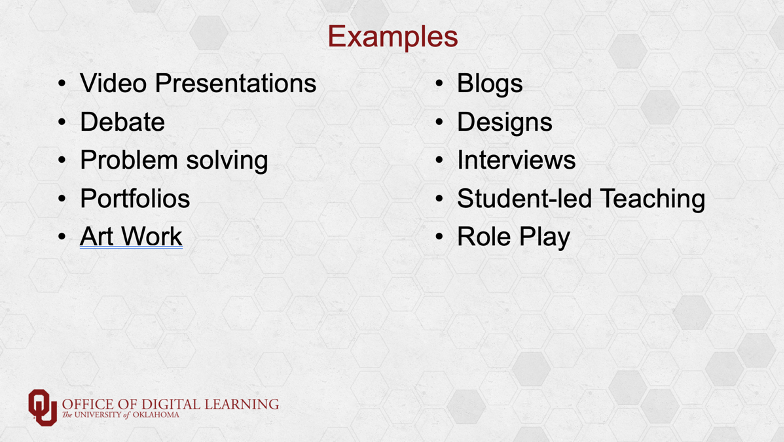Action-Based Assessments
How many of you felt a rush of panic when you received the news that we would be transitioning all on-ground courses to online for the remainder of the semester? You are not alone. Many students and faculty have felt the anxiety of transitioning to online. Have no fear! We are here to help ease any concerns you may have regarding online assessment strategies. It is important to recognize that students’ environments have changed – their access to technology, to speedy internet, a quiet study space or time alone may all be greatly impacted. When and where you can, try to be flexible. It is also important to acknowledge that not every student is out to cheat in the online learning environment.
What is Action-Based Assessment?
Action-based assessment is exactly how it sounds – assessing students’ ability to complete a task using the knowledge and skills acquired throughout the course. As educators, one of the goals is to prepare students for life outside of the classroom. Rarely, if ever, will a student be asked to complete a real-world task without the ability to utilize resources, tools or to collaborate with their team members. It only makes sense to ask students to demonstrate their knowledge of the material and to be evaluated using a rubric that outlines expectations.
Traditional vs. Action-Based Assessment
Traditional assessment and action-based assessment strategies are different in several ways. It is not my intention to discredit traditional assessment methods, but to provide some alternative ways of testing and evaluating learner performance. With the rapid transition to online, it is important to be open-minded and flexible. Let’s discuss the key differences between the two assessment methods.
Traditional assessment offers indirect evidence of learning. For example, students are often asked to select a response. By simply selecting a response, it is hard to know for certain whether a student has acquired the knowledge or if they chose the correct answer at random. With action-based assessments, students are able to demonstrate their knowledge in a more meaningful way and with more complex application. From action-based assessment types, we are more able to determine if the student has acquired the construction and application of knowledge. For example, we are better able to assess if the student is able to competently critique an argument, debate a peer, or lead a lesson – all of which are skills that would be applicable to the real world.
Traditional assessment methods are instructor-focused – meaning, there are very specific, instructor-selected competencies that are being assessed through methods like multiple choice answer selection, fill in the blank, and true/false – and are mostly, recall based.
Action-Based assessment, on the other hand, is student-focused. You are asking the student to demonstrate knowledge by performing real-world tasks. Of course, there should be structure and guidance in the form of a rubric that clearly outlines how the students will be evaluated. We will talk more about rubrics in a bit.
Examples
With a little flexibility, open mindedness, trust and creativity, you will see there are several different ways to assess student knowledge through action-based activities. These are just a few examples.

Instead of asking students to write essays or research papers, ask students to blog as a way to assess their knowledge of the course material. In addition to video presentations, debates and role playing, challenge students to solve real-world problems. For some courses, it may be appropriate for students to create and submit a portfolio, artwork or design. The added bonus of these types of assessments is that the students leave the course with a professional, tangible work sample for future employment or activities.
The Importance of a Rubric
When using action-based assessments, it is important to provide students with a rubric. Additionally, it is also important to design a rubric as part of the assessment development process – which we will discuss next. Each rubric should include criteria and level of performance. You may also choose to include descriptors, which spell out exactly what is expected at each level of performance. You should share the rubric with the students before they complete the action-based assessment. Here you will see a sample rubric based on a blog post assignment.

Creating Action-Based Assessments
Let’s walk through the steps to create an action-based assessment by answering these questions:
- To identify the standards to be assessed, ask yourself – what should students know and be able to do?
- When choosing a task, ask yourself – what indicates students have met the standards?
- When setting criteria, ask yourself – what does good performance on this task look like?
- When creating a rubric, ask yourself – how well did the students perform?
If the standard is to hit a golf ball, then our task may be to ask the students to record a video of them hitting a golf ball. The criteria we may choose to set could be the golf club making contact with the ball and our rubric should evaluate the varying degrees of performance on this task. You may find mapping out your standard, task and criteria to be helpful while creating assessments.

Share This Page

